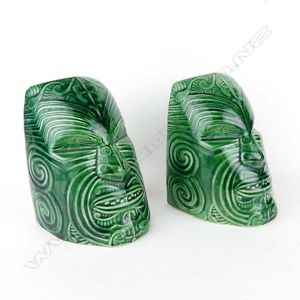
Crown Lynn Greenstone Ceramica Vase with Leaf Design
A Crown Lynn greenstone Ceramica vase, with impressed leaf design top the exterior. Shape number 2034, height 16.9 cm, depth 9 cm

Crown Lynn Greenstone Ceramica Vase: Leaf Design, Shape 2036
A Crown Lynn greenstone Ceramica vase, with impressed leaf design to the exterior. Shape mark 2036, height 10.5 cm, depth 7.4 cm

Crown Lynn Greenstone Ceramica Vase with Leaf Design
A Crown Lynn greenstone Ceramica vase, with impressed leaf design to the exterior. Shape number 2035, height 12.4 cm, depth 9.7 cm

Crown Lynn Greenstone Ceramica Vase with Foliage Design
A Crown Lynn greenstone Ceramica vase, impressed foliage to body. Shape number 2034 to base, height 17 cm, depth 9.1 cm

Greenstone Leaf Impressed Ceramica Vase: Crown Lynn (Shape 2036)
A Crown Lynn greenstone Ceramica vase, with impressed leaf design to the exterior. Shape number 2036, height 10.5 cm, depth 7.5 cm

Greenstone Ceramica Vases Set
A set of matching Crown Lynn 'Greenstone Ceramica' vases, the larger pair with an impressed shape number '2035' to base, the smaller pair with '2036', height 13 cm, diameter 9.5 cm

Greenstone Ceramica Vase with Foliage Impression, Crown Lynn
A Crown Lynn 'Greenstone Ceramica' vase, impressed foliage to body. Shape number 2034 to base, height 17 cm, diameter 10 cm

Greenstone Ceramica Vase with Foliage Impression - Crown Lynn
A Crown Lynn 'Greenstone Ceramica' vase, impressed foliage to body. Shape number 2034 to base, height 17 cm, diameter 10 cm

Greenstone Ceramica Vase with Foliage Impression - Crown Lynn
A Crown Lynn 'Greenstone Ceramica' vase, impressed foliage to body. Shape number 2034 to base, height 17 cm, diameter 10 cm

Greenstone Ceramica Vase with Foliage Impression - Crown Lynn
A Crown Lynn 'Greenstone Ceramica' vase, impressed foliage to body. Shape number 2034 and maker's mark to base, height 18 cm, diameter 10 cm

Pair of Crown Lynn Greenstone Ceramica Vases
A pair of Crown Lynn 'Greenstone Ceramica' vases, each with shape number 2035 raised in relief to base, height 13 cm, diameter 10 cm each

Greenstone Ceramica Vase by Crown Lynn
A Crown Lynn 'Greenstone Ceramica' vase, impressed foliage to body. Shape number 2034 and maker's mark to base, height 17.5 cm, diameter 10 cm

Greenstone Ceramica Trough Vases (Set of 3)
A trio of Crown Lynn 'Greenstone Ceramica' trough vases, each with shape number 2037 impressed to base. The white green glaze with maker's stamp to base, height .6 cm, width 7 cm, length 18 cm

Greenstone Ceramica Vase by Crown Lynn
A Crown Lynn 'Greenstone Ceramica' vase, impressed foliage to body. Shape number 2034 and maker's mark to base, height 17 cm, diameter 10 cm

Matching Crown Lynn Greenstone Ceramica Vases (Set of 3)
A trio of matching Crown Lynn 'Greenstone Ceramica' vases, each with impressed shape number 2036 to base, height 10 cm, diameter 9 cm

Crown Lynn Greenstone Ceramica Vases - Pair
A pair of Crown Lynn 'Greenstone Ceramica' vases, impressed shape number 2035/2036 and maker's stamp to base of each. Largest, height 13 cm, diameter 10 cm

Graduating Crown Lynn Greenstone Ceramica Vases Trio
A trio of graduating Crown Lynn 'Greenstone Ceramica' vases, each with shape number and made in New Zealand to base. Largest, height 18 cm, diameter 9 cm

Crown Lynn Wharetana Ware 'Moko' Bookends
A pair of Crown Lynn Wharetana ware 'Moko' bookends, recorded in the promotional pamphlet as 'Ceremonial Life-Sized wooden masks... The face moko (tattoo) is typical of a Maori chief or tohunga...', striking dark green glaze, impressed model 1019 to base…

Maori Wall Plate with Portrait & Carving Design
A Crown Lynn Wharetana wall plate (plaque) 'Puhi Urutapu Tamahine', brown glaze with mild relief Maori portrait framed by a stylised Maori carving. Impressed number to the reverse '1023', diameter 25.5 cm. Note: The original catalogue refers to this…

Maori Portrait Wall Plate with Traditional Hei Tiki Charm
A Crown Lynn Wharetana wall plate (plaque) 'Puhi Urutapu Tamahine', green glaze with mild relief Maori portrait framed by a stylised Maori carving. Diameter 25.5 cm impressed number to the reverse '1023'. The original catalogue refers to this plaque as…
 Loading more...
Loading more...